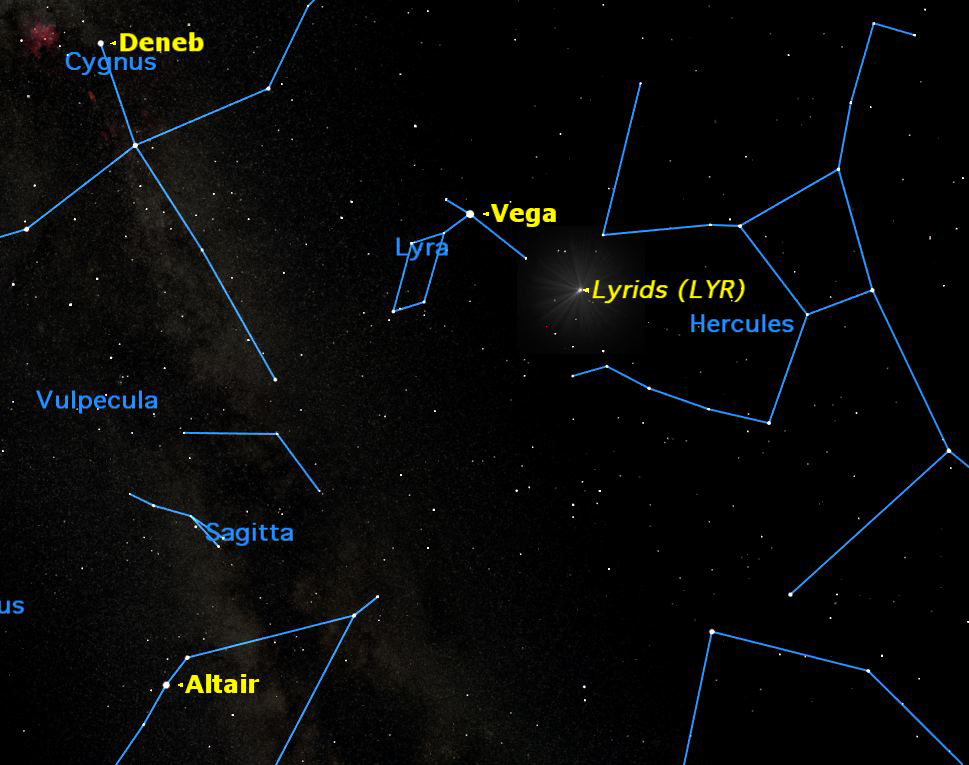Lyrid Meteor Shower Peaks This Week

Editor's note: for our complete coverage of the 2012 Lyrid meteor shower, visit here: Lyrid Meteor Shower of 2012: A Skywatching Resource
An annual meteor shower peaks this weekend, a time when dark skies should make for great viewing opportunities in the Northern Hemisphere.
The Lyrid meteor shower is expected to reach maximum intensity overnight from Saturday to Sunday (April 21 to 22), with the best observing opportunities coming between midnight and dawn on the 22nd local time, experts say. The moon will be nearly new at that time, so its glare shouldn't drown out too many of the Lyrids' brief flashes.
The dark skies could make a big difference for meteor-watchers, because the Lyrids are historically a mild shower. NASA forecasters expect a peak rate of 15 meteors per hour this weekend, though the Lyrids have produced outbursts of 100 per hour in past years.
And just as the Lyrids' peak rate can vary dramatically, so too can the brightness of each individual meteor. [Lyrid Meteor Shower From Comet Thatcher (Video)]
"Lyrid meteors are typically as bright as the stars in the Big Dipper, which is to say of middling brightness," the website Spaceweather.com writes in a recent skywatching guide. "But some are more intense, even brighter than Venus. These 'Lyrid fireballs' cast shadows for a split second and leave behind smoky debris trails that linger for minutes."
Meteor showers are generated when Earth plows through streams of debris shed by comets on their path around the sun. These icy, dusty chunks burn up in our planet's atmosphere, leaving behind bright streaks in the sky to commemorate their passing.
Breaking space news, the latest updates on rocket launches, skywatching events and more!
The Lyrids' parent comet is called C/1861 G1 Thatcher (Comet Thatcher for short). The Lyrids take their name from the constellation Lyra (The Lyre), because they appear to emanate from this part of the sky. Lyra is a northern constellation, so skywatchers in the Northern Hemisphere generally get much better looks at the Lyrids every year than do folks who live south of the equator.
But anyone with a computer and an Internet connection should be able to see the Lyrids this weekend. NASA will air live footage of the shower as seen by the agency's meteor cameras, and experts Bill Cooke, Danielle Moser and Rhiannon Blaauw — all of NASA's Marshall Space Flight Center in Huntsville, Ala. — will stay up late to take your questions.
To view the shower online and participate in the chat, check out the following website between 11 p.m. and 5 a.m. EDT (0400 to 0900 GMT) overnight on the 21st and 22nd: http://www.nasa.gov/connect/chat/lyrids2012_chat.html
You can follow SPACE.com senior writer Mike Wall on Twitter: @michaeldwall. Follow SPACE.com for the latest in space science and exploration news on Twitter @Spacedotcom and on Facebook.

Michael Wall is a Senior Space Writer with Space.com and joined the team in 2010. He primarily covers exoplanets, spaceflight and military space, but has been known to dabble in the space art beat. His book about the search for alien life, "Out There," was published on Nov. 13, 2018. Before becoming a science writer, Michael worked as a herpetologist and wildlife biologist. He has a Ph.D. in evolutionary biology from the University of Sydney, Australia, a bachelor's degree from the University of Arizona, and a graduate certificate in science writing from the University of California, Santa Cruz. To find out what his latest project is, you can follow Michael on Twitter.
